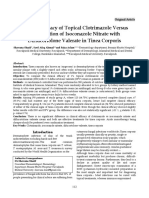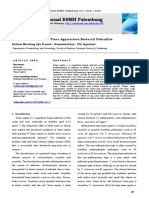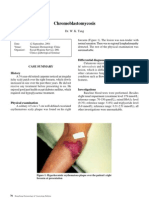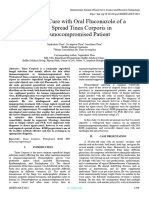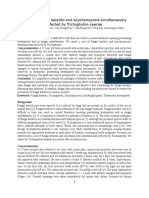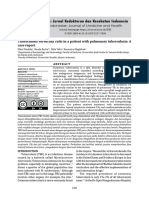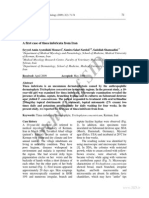Tinea Corporis Caused by Microsporum Audouinii: Case Report
Tinea Corporis Caused by Microsporum Audouinii: Case Report
Uploaded by
Arasti Qisthi VanzifaCopyright:
Available Formats
Tinea Corporis Caused by Microsporum Audouinii: Case Report
Tinea Corporis Caused by Microsporum Audouinii: Case Report
Uploaded by
Arasti Qisthi VanzifaOriginal Title
Copyright
Available Formats
Share this document
Did you find this document useful?
Is this content inappropriate?
Copyright:
Available Formats
Tinea Corporis Caused by Microsporum Audouinii: Case Report
Tinea Corporis Caused by Microsporum Audouinii: Case Report
Uploaded by
Arasti Qisthi VanzifaCopyright:
Available Formats
CASE REPORT
TINEA CORPORIS CAUSED BY MICROSPORUM AUDOUINII
Mungky Sukarnadi, Safruddin Amin, Wiwiek Dewiyanti Department of Dermatovenereology Medical Faculty of Hasanuddin University / Wahidin Sudirohusodo Hospital Makassar
ABSTRACT
Tinea corporis is a superficial dermatophyte fungal infection of the trunk, leg and arm region. These infections are by the caused by species of Trichophyton, Epidermophyton and Microsporum. One case of tinea corporis et causa Microsporum audouinii in a 61 years old woman was reported. Diagnosis was established based on history, physical examination, direct microscopic examination with potassium hydroxide (KOH 10%) and culture. The patient was treated with oral ketoconazole and topical treatment contains a combination of Salicyl acid 3%, 6% benzoic acid and vaseline 30gr (AAV1). Eight days after therapy, the patient showed clinical and mycological improvement. Key words: Microsporum audouini, ketoconazole, tinea corporis
Address for correspondence : Mungky Sukarnadi, dr., Department of Dermatovenereology Medical Faculty of Hasanuddin University / Wahidin Sudirohusodo Hospital Makassar, 11 Komp. TNI AL Dewakang Jl. Koptu Harun Makassar, South Sulawesi, Indonesia 90245, smungky@yahoo.com
39
Mungky Sukarnadi
tinea corporis caused by microsporum audouinii
INTRODUCTION Dermatophytosis is a superficial infection caused by dermatophyte fungi on keratincontaining tissues such as nails, hair and stratum corneum of the skin. Tinea corporis is a superficial fungal infection caused by dermatophytes on regional bodies, legs, and arms. ( 1-3 ) Dermatophyte fungi are classified based on habitat or source of infection, ie geophilic, zoophilic, and anthropophilic. Three fungi most commonly found in cases of tinea corporis is Trichophyton rubrum, Trichophyton mentagrophytes and Epidermophyton floccosum. Trichophyton rubrum, Microsporum canis and Trichophyton mentographytes a common cause in the United States. Some species have a predilection for certain body parts, such as Microsporum audouinii typical cause of tinea capitis and Trichopyton rubrum which generally causes tinea pedis, but they also can cause tinea corporis. ( 1 , 4-6 ) The incidence of dermatophyte infection according to a survey World Health Organization (WHO) that approximately 20% of people worldwide are infected, especially tinea corporis (70%), followed by tinea cruris, tinea pedis and onychomycosis. ( 7 ) Incident dermatomycosis in Indonesia shows the highest incidence of dermatophytosis followed by pityriasis versicolor and candidiasis skin. ( 8 ) Clinical picture of tinea corporis varied, can be demarcated erythematous plaques with more rising edge and the center of the lesion tends to heal (central healing). Adjacent lesions can coalesce to form polycyclic pattern. Lesions of tinea corporis can also serpiginous and annular (ringworm-like). ( 1 )
Diagnosis of tinea corporis can be established based on history, physical examination and investigation by direct microscopic examination and culture. ( 1 , 9 , 10 ) Patient with tinea corporis usually responds well to topical antifungal treatment within 2-4 weeks. Various preparations allilamin, imidazole, and available in several forms. Patient with extensive lesions or fail with topical treatments, anti-fungal preparations can be administered orally, such as griseofulvin, ketoconazole, itraconazole and terbinafin. ( 1 , 11 , 12 ) Microsporum audounii is a dermatophyte fungus anthropophilic group most likely to cause tinea capitis, although rarely reported to cause tinea corporis. ( 4 , 5 , 13 ) In this paper, we reported a case of tinea corporis in a woman 61 years old caused by Microsporum audouinii CASE REPORT A woman aged 61 years old, occupation a housewife came to dermatovenereology clinic Wahidin Sudirohusodo hospital with chief complaint red spots on the upper left arm since 1 year ago. Patient also complained of itchy, and while sweating itchy getting worse . Initially lesion showed reddish patches scaly and became larger. Previous history of similar complaints (+). History of its own lubrication purchased at pharmacies (not known the title), but not improved. Family history of similar disease undeniable. Denied a history of diabetes mellitus. Denied a history of allergy. Physical examination on the region of the left brachial showed erythema plaques with elevated edges and fine scales . (Figure 1.AB)
40
IJDV
Vol.2 No.2 2013
On microscopic examination using staining Lactophenol Cotton Blue (LCB) of culture looks macroaleurospora and bizarre branching. (Figure 4.AB)
Figure 1. Erythematous plaques with elevated edges and fine scales on the the left brachial region
Direct microscopic examination of skin scrapings of the lesion with KOH 10% solution showed insulated length and branching hyphae. (Figure 2)
Figure 4A. Macroaleurospora 4B. Branching Bizarre
Figure 2. Long, septate and branching hyphae on KOH 10% examination
Culture examination conducted by the specimen scrapings of skin lesions on media Saboroud's Dextrose Agar (SDA). Macroscopic picture looks a brownish red colonies with elevated surfaces and edges are white gray, bottom looks brownish yellow colonies. (Figure 3.AB)
Final diagnosis is established tinea corporis caused by Microsporum audouinii. Management of this case oral ketoconazole 200 mg per day, and topical therapy contains 3% salicylic acid , benzoic acid 6% and vaseline 30gr (AAV1) applied two times a day. On day 8 therapy, clinical improvement appeared in the form of macular hypopigmentation with complaint of itching diminished. (Figure 5). Direct microscopic examination with 10% KOH showed negative result and continued therapy.
Figure 3A. SDA culture day 21 showed a brownish red colonies with elevated surfaces and edges are white gray. 3B. Bottom side showed brownish yellow colonies.
41
Mungky Sukarnadi
tinea corporis caused by microsporum audouinii
In our case, on day 21 macroscopically showed maroon colonies with elevated surface and gray white edge, the bottom side showed brownish yellow colonies. Microscopic picture looks macroaleurospora and bizarre branching. Culture results according to Microsporum audouinii. ( 15 ) Microsporum audouinii an anthropophilic dermatophyte fungi spesises which is one of the most frequent causes of dermatophytes (61.5%) in tinea capitis, especially in children who are in Latin America and South Africa, but this species can also infect the skin and nails. ( 13 ) Reported a young woman from Germany with tinea corporis due to Microsporum audouinii accompanied by tinea capitis.( 16) Systemic antifungal therapy is indicated if the lesions are extensive or fails to topical treatment, recurrent or chronic, or if the skin condition gets worse. ( 11 , 12 ) Ketoconazole is an antifungal systemic broad spectrum imidazole group and is fungistatic. Mechanism of action of ketoconazole that inhibit the biosynthesis of ergosterol, the main sterol which serves to maintain the integrity of the fungal cell membrane, by inhibiting the enzyme cytochrome P-450 lanosterol 14 demetilase an enzyme essential for fungal cell membrane ergosterol synthesis. ( 4 , 7 , 12 ) In a study to compare strength between itraconazole and fluconazole and the ketoconazole and fluconazole obtained similar results with a cure rate of approximately 90% for all three drugs. ( 17 ) In this case , patient was treated ketoconazole 200 mg per day. On day 8 therapy, lesions looks macular hypopigmentation, itching diminished and negative KOH examination. Other oral anti-fungal medication that can be given to tinea corporis is fluconazole, itraconazole, griseofulvin, and terbinafin. On a compa42
Figure 5. On the day 8 therapy showed macular hypopigmentation.
DISCUSSION In this case report, patient diagnosed tinea corporis caused by Microsporum audouinii based on history, physical examination and investigations using direct microscopic examination followed by culture examination to determine the cause of the species. Tinea corporis is a disease that causes itching and complaints intensified when the patient sweats. Clinical picture of tinea corporis vary, and may be macular erythematous plaque with an active edge and accompanied squama, with the center of the cure (central healing). ( 1 ) In this case, patient complaints of itching erythematous plaques with elevated edges and fine scales on the left brachial region. Microscopic examination of skin scrapings specimens using 10% KOH solution is a simple diagnostic method to see length hyphae, branched hyphae, and arthospora Scales collected by scrape edge of an active lesion, then dropped 10-20% KOH solution. ( 1 , 4 , 5 , 14 ) In this case KOH 10% examination showed length and branching hyphae. Fungal culture is used to confirm the diagnosis and identify pathogenic species. Culture media is a selective medium for the isolation of dermatophytes, and then stored at a temperature of 26 0 C
IJDV
Vol.2 No.2 2013
rative study of adults showed fluconazole 150 mg per week for 4 to 6 weeks, itraconazole 100 mg per day for 15 days and terbinafin 250 mg per day for 2 weeks is as effective by administering griseofulvin 200 mg per day for 2 to 6 weeks. ( 1 ) Research conducted comparing Clayton and Connor clotrimazole cream and Whitfield's ointment was not found significant differences and showed negative mycological results after 4 weeks of treatment. Whitfield's ointment is fungistatic and keratolytic. ( 18 , 19 ) In this case, topical treatment with AAV1/Whitfield 's ointment was applied two times a day. Non-medicamentous management by reducing the predisposing factors, suggest to wear loose clothing and absorb sweat, dry off after shower and sweating. ( 2 ) REFERENCES
1. Verma S, Heffernan MP. Superficial Fungal Infection: dermatophytosis, Onychomycosis, Tinea Nigra, Piedra. In: Wolff K, Goldsmith LA, Katz SI, Gilchrest BA, Paller AS, editors. Fitzpatrick's Dermatology in General Medicine. 8 ed. New York: Mc Graw Hill; 2012. p. 227697. Hay RJ, Ashbee HR. Mycology. In: Burns T, Breathnach S, Cox N, Griffiths C, editors. Rook's textbook of dermatology. West Sussex: Wiley-Blackwell; 2010. p. 36.1-92. Charles AJ. Superficial cutaneous fungal infections in tropical countries. Dermatologic Therapy. 2009; 22:550-9. Gupta AK, TH Linh. Dermatophytes: Diagnosis and treatment. J Am Acad Dermatol. 2008; 50:748-52. Richardson MD, Warnock DW. Dermatophytosis. Fungal Infection Diagnosis and Management. 3 ed. USA: Blackwell; 2003. p. 80-108. James WD, Berger TG, Elston DM. Diseases Resulting From Fungi And yeasts. Andrews' diseases of the skin: clinical dermatology. Canada: Elsevier Saunders; 2006. p. 297-307.
7.
8.
9.
10.
11.
12.
13. 14.
2.
15.
16.
3.
4.
17.
5.
18.
19.
6.
Lakshmipathy DT, Kannabiran K. Review on dermatomycosis: pathogenesis and treatment. Natural Science. 2010; 2:726-31. Goedadi M. Tinea corporis and tinea cruris. In: Budimulja U, Kuswadji, Bramono K, Menaldi S, Dwihastuti P, Widaty S, editors. Dermatomikosis superficial. Jakarta: Balai Publisher Faculty of Medicine, University of Indonesia; 2004. Habif TP. Superficial Fungal Infection. In: Habif TP, editor. Clinical dermatology: A color guide to diagnosis and therapy. 4 ed. USA: Mosby; 2003. p. 409-39. Matnani I, Gandham N, Mandal A. Identification And Antifungal Susceptibility Testing Of Fungal Infections In Clinical Samples Of Suspected Superficial Fungal Infections. Int J of Med and Clin Res. 2012; 3 (7) :215-20. Drake LA, Chairman, Dinehart SM, Farmer ER, Goltz RW, Graham GF. Guidelines of care for superficial mycotic infections of the skin: Tinea corporis, tinea cruris, tinea faciei, tinea manuum, and tinea pedis. J Am Acad Dermatol. 2008; 34:282-6. Rand S. Overview: The treatment of dermatophytosis. J Am Acad Dermatol 2008; 43: S104-12. Microsporum audouinii. Clin Micro Test. 2008:1-2. Chaya AK, Pande S. Methods of specimen collection for diagnosis of superfi cial and subcutaneous fungal infections. Leprol Indian J Dermatol Venereol. 2007:202-5. Frey D, Oldfield RJ, Bridger BC. A color atlas of pathogenic fungi. Holland: Wolfe Medical Publications; 1985. p. 22. Brasch J, Hugel R, Lipowsky F, Graser Y. Tinea corporis by the caused by an unusual strain of Microsporum audouinii that perforates hair Mycoses 2009; 53:360-2. Thomas B. Clear choices in managing epidermal tinea infections. The J Fam Pract. 2007:850-62. Antifungal Drugs. Prescribing the World Health Organization Model Information Drugs use in Skin Diseases 1997. p. 74-90. YM Clayton, Connor BL. Comparison of clotrimazole cream, Whitfield's ointment and nystatin ointment for the topical treatment of ringworm infections, pityriasis versicolor, and candidiasis erythrasma. Br J Dermatol. 2008:297-303.
43
You might also like
- 663 1041 1 SMDocument8 pages663 1041 1 SMIvan FirmansyahNo ratings yet
- Therapy Selection For Tinea Corporis and Cruris With CommorbidityDocument9 pagesTherapy Selection For Tinea Corporis and Cruris With CommorbidityShimie Shimie KokobopNo ratings yet
- Trichophyton Mentagrophytes Type Granular In: Tinea Corporis and Tinea Cruris Caused by Asthma Bronchiale PatientDocument8 pagesTrichophyton Mentagrophytes Type Granular In: Tinea Corporis and Tinea Cruris Caused by Asthma Bronchiale PatientMaisura RaRaNo ratings yet
- 668 1051 1 SMDocument7 pages668 1051 1 SMSigit KurniawanNo ratings yet
- Penyebab Baru OsteomyelitisDocument3 pagesPenyebab Baru OsteomyelitisIka Benny Kartika SariNo ratings yet
- Mycotic Necrotizing Fasciitis of the Face a Case Report and Review of LiteratureDocument6 pagesMycotic Necrotizing Fasciitis of the Face a Case Report and Review of LiteratureAthenaeum Scientific PublishersNo ratings yet
- Experimental Study On Cryotherapy For Fungal Corneal Ulcer: Researcharticle Open AccessDocument9 pagesExperimental Study On Cryotherapy For Fungal Corneal Ulcer: Researcharticle Open AccessSusPa NarahaNo ratings yet
- Tinea CorporisDocument7 pagesTinea CorporisAziza Ulfie WijayaniNo ratings yet
- 2018 1-S2.0-S2211753917300696-MainDocument3 pages2018 1-S2.0-S2211753917300696-MainSoraya Eugenia Morales LópezNo ratings yet
- Therapeutic Hotline: Tinea Profunda of The Genital Area. Successful Treatment of A Rare Skin DiseaseDocument3 pagesTherapeutic Hotline: Tinea Profunda of The Genital Area. Successful Treatment of A Rare Skin Diseasesoekarnohatta94No ratings yet
- Tinea CorporisDocument7 pagesTinea CorporisAziza Ulfie WijayaniNo ratings yet
- Spectrum of Fungal Keratitis: Clinicopathologic Study of 44 CasesDocument4 pagesSpectrum of Fungal Keratitis: Clinicopathologic Study of 44 CasesRichardNo ratings yet
- CorinebakteriumDocument6 pagesCorinebakteriummillaNo ratings yet
- Jurnal RSMH Palembang: Black Dot Type Capitis Tinea Appreciates Bacterial FoliculitisDocument5 pagesJurnal RSMH Palembang: Black Dot Type Capitis Tinea Appreciates Bacterial FoliculitisLailatuz ZakiyahNo ratings yet
- Jof 03 00017Document10 pagesJof 03 00017Asterlita RyaneNo ratings yet
- Crs LinDocument4 pagesCrs LinPoolerErNo ratings yet
- Review Article: Profile of Corneal Ulcer in A Tertiary Eye Care CentreDocument6 pagesReview Article: Profile of Corneal Ulcer in A Tertiary Eye Care CentreNadhila ByantNo ratings yet
- Chromoblastomycosis: Differential DiagnosesDocument4 pagesChromoblastomycosis: Differential DiagnosesPranab ChatterjeeNo ratings yet
- Piis0002939410000668 PDFDocument6 pagesPiis0002939410000668 PDFJennifer ChávezNo ratings yet
- Clinically Cure With Oral Fluconazole of A Wide Spread Tinea Corporis in Immunocompromised PatientDocument5 pagesClinically Cure With Oral Fluconazole of A Wide Spread Tinea Corporis in Immunocompromised PatientInternational Journal of Innovative Science and Research TechnologyNo ratings yet
- JCDR 8 DD01Document4 pagesJCDR 8 DD01ojiNo ratings yet
- Jurnal Primer - Fluconazole Versus Itraconazole in The Treatment of Tinea VersicolorDocument8 pagesJurnal Primer - Fluconazole Versus Itraconazole in The Treatment of Tinea VersicolorKopitesNo ratings yet
- Noma As ALL RelapseDocument5 pagesNoma As ALL RelapseSatyakiranNo ratings yet
- PDF DocumentDocument4 pagesPDF DocumentAditya Yudha PratamaNo ratings yet
- Ing GrisDocument3 pagesIng GrisJericho JeruzalemNo ratings yet
- Treatment of Toxic Epidermal Necrolysis With Intravenous ImmunoglobulinDocument5 pagesTreatment of Toxic Epidermal Necrolysis With Intravenous ImmunoglobulinUbaidillah HafidzNo ratings yet
- Itraconazole Therapy in Pityriasis VersicolorDocument10 pagesItraconazole Therapy in Pityriasis VersicolorKopitesNo ratings yet
- The Prevalence of Interdigital Erythrasma in Southern Region of TurkeyDocument5 pagesThe Prevalence of Interdigital Erythrasma in Southern Region of TurkeyJennifer JaneNo ratings yet
- Darier-White Disease: A Rare Genetic DisorderDocument4 pagesDarier-White Disease: A Rare Genetic Disorderanis utamiNo ratings yet
- Effect of FGF10 Monoclonal Antibody On Psoriasis-Like Model in Guinea Pigs.Document10 pagesEffect of FGF10 Monoclonal Antibody On Psoriasis-Like Model in Guinea Pigs.pancholarpancholarNo ratings yet
- 42thilak EtalDocument3 pages42thilak EtaleditorijmrhsNo ratings yet
- DRES SindromeDocument6 pagesDRES SindromeleslyjanetNo ratings yet
- Diagnosis BandingDocument7 pagesDiagnosis BandingSyafar SmNo ratings yet
- Treatment of Vitiligo With Narrow-Band UVB and Topical Gel Containing Catalase and Superoxide DismutaseDocument5 pagesTreatment of Vitiligo With Narrow-Band UVB and Topical Gel Containing Catalase and Superoxide DismutaseBen IntosiusNo ratings yet
- The Use of Isotretinoin in The Treatment of Chronic Deep Dermatophyte InfectionsDocument2 pagesThe Use of Isotretinoin in The Treatment of Chronic Deep Dermatophyte InfectionsBharathi RagavanNo ratings yet
- Eryth Ras MaDocument5 pagesEryth Ras MaGilar Kusuma HadiNo ratings yet
- Malassezia FolliculitisDocument5 pagesMalassezia Folliculitisshivam18No ratings yet
- Critical Appraisal OM - Ni WayanDocument7 pagesCritical Appraisal OM - Ni WayanwayanNo ratings yet
- 86 90 Case Report - Leishmaniasis - Audi - PDF 86 90 PDFDocument5 pages86 90 Case Report - Leishmaniasis - Audi - PDF 86 90 PDFJeddhie MoraNo ratings yet
- MainDocument4 pagesMainisminireeyNo ratings yet
- Cutaneous Aspergilosis Caused by Aspergillus Flavus: A Case ReportDocument6 pagesCutaneous Aspergilosis Caused by Aspergillus Flavus: A Case ReportAditya Yudha PratamaNo ratings yet
- Veraldi2017 PDFDocument3 pagesVeraldi2017 PDFMatius Wilson AdoeNo ratings yet
- New Protocol To Treat Corneal Ulcer: 2 Years Retrospective ExperienceDocument4 pagesNew Protocol To Treat Corneal Ulcer: 2 Years Retrospective Experiencetocx1xNo ratings yet
- C CA AS SC CL Liin Niiq QU UE E // C CA AS SE ER RE EP PO OR RT TDocument7 pagesC CA AS SC CL Liin Niiq QU UE E // C CA AS SE ER RE EP PO OR RT TG Virucha Meivila IINo ratings yet
- A Case of Skin and Soft Tissue Infection Caused by Mycobacterium AbscessusDocument4 pagesA Case of Skin and Soft Tissue Infection Caused by Mycobacterium AbscessusAnonymous so6ZnlKywNo ratings yet
- Disseminated Tinea Incognita in A Patient With Ichthyosis Vulgaris and EczemaDocument3 pagesDisseminated Tinea Incognita in A Patient With Ichthyosis Vulgaris and EczemaNovia KurniantiNo ratings yet
- A Case Report of Eumycetoma Early DX CaseDocument3 pagesA Case Report of Eumycetoma Early DX CasesiskaNo ratings yet
- LK - Alergi 1Document8 pagesLK - Alergi 1DewiSartikaNo ratings yet
- Jurnal Mata 2Document5 pagesJurnal Mata 2lathifa_nurNo ratings yet
- Clinical and Microbiological Study of Tinea Unguium in A Tertiary Care CentreDocument7 pagesClinical and Microbiological Study of Tinea Unguium in A Tertiary Care CentreRebeka SinagaNo ratings yet
- Archive of SID: A First Case of Tinea Imbricata From IranDocument4 pagesArchive of SID: A First Case of Tinea Imbricata From IrangerryajunNo ratings yet
- GJHS 5 150Document5 pagesGJHS 5 150Wisnu Aditya WardanaNo ratings yet
- Acne Vulgaris 3Document27 pagesAcne Vulgaris 3Ridho ForesNo ratings yet
- Concurrent Basal Cell and Squamous Cell Carcinomas Associated With Hydroxyurea TherapyDocument4 pagesConcurrent Basal Cell and Squamous Cell Carcinomas Associated With Hydroxyurea Therapyanisse89No ratings yet
- Admin, 24 Mukundh Chaithanya FINALDocument5 pagesAdmin, 24 Mukundh Chaithanya FINALLaili Nurul IslamiNo ratings yet
- Junal PyodermaDocument6 pagesJunal PyodermaJares Clinton Saragih SimarmataNo ratings yet
- Maat 08 I 1 P 40Document3 pagesMaat 08 I 1 P 40mazdaraceway_lagunasecaNo ratings yet
- Childhood PsioriasisDocument6 pagesChildhood PsioriasisYuliana DaisongNo ratings yet
- Pemphigoid Vegetans in Childhood: A Case Report and Short Review of LiteratureDocument11 pagesPemphigoid Vegetans in Childhood: A Case Report and Short Review of LiteratureCata santaNo ratings yet
- Diagnostics to Pathogenomics of Sexually Transmitted InfectionsFrom EverandDiagnostics to Pathogenomics of Sexually Transmitted InfectionsSunit Kumar SinghNo ratings yet







